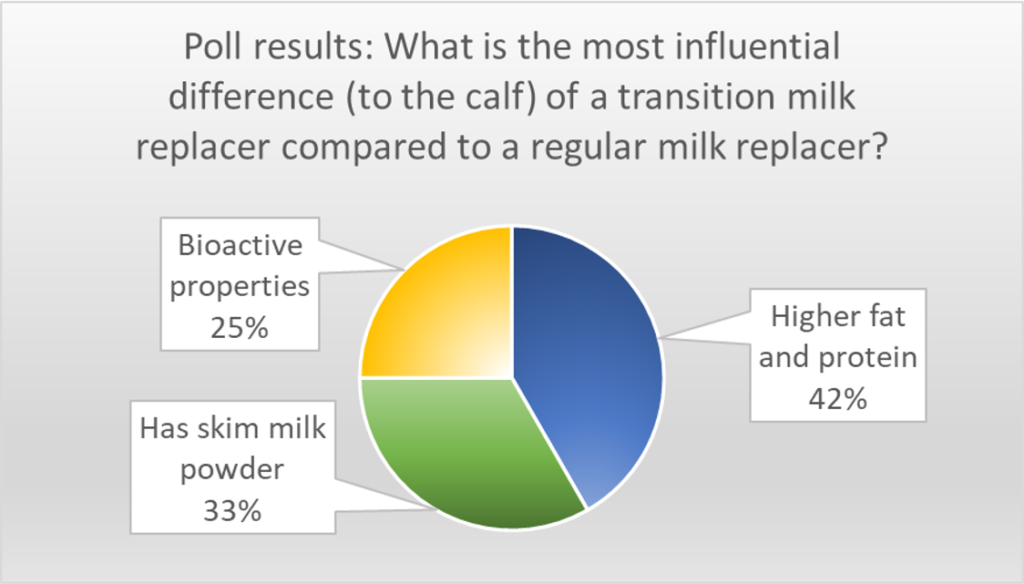Calf rearing is a series of milestones, not least the animal’s transition to becoming a ruminant. For participants in a recent CalfChat social media evening, rumen development was considered by half of those polled as the major development in the calf’s first weeks.
But Dr. Christine Cummins, of Bonanza Calf Nutrition, suggests that another phase must first be considered.
After a calf is born, its gut must develop – physically, and its microbial environment. This extends beyond 24 hours, the well-known marker for ‘gut closure’.
After colostrum feeding, the gut cannot absorb immunoglobulins, the antibodies that provide immunity to the calf in its early days, according to Dr. Cummins.
“The gut still has lots of work to do after this, therefore the big transition in the first weeks’ of life is intestinal development,’’ she said.
“A calf is working hard to develop the intestines to become efficient at digesting milk and to protect itself from bad bugs.’’
It takes approximately three weeks for the gut’s microbial community and physical structure to be highly efficient.
It is the first two weeks of these that are the most challenging. The length of time it takes for the gut to build itself up is affected by both feed type and environmental challenges.

Why is this?
Dr. Cummins said that although the gut is inside the calf it is like an external skin, exposed to all the things the calf encounters in the outside world.
“It must therefore be able to withstand the physical and chemical abrasions of food and continuous attacks from pathogens, all while efficiently digesting the food being consumed,’’ she said.
Highly challenging conditions slow or possibly reverse physical development of the gut while pathogenic organisms take up space that could be populated by beneficial bacteria.
What role does transition milk play in this?
60% of the CalfChat participants said that they believed that this milk promoted a healthy gut, while 33.3% thought only colostrum was needed.
Dr. Cummins said that within a few days of birth, the cells lining the small intestine have been shed and replaced with new cells; the surface antibody of colostrum is depleted, leaving the new cells highly vulnerable to challenges.
“Transition milk contains surface antibodies to promote the health of the gut and maintenance of gut integrity as it continues to develop,’’ she said.
Transition milk also contains oligosaccharides, a carbohydrate which acts as a prebiotic for beneficial bacteria and a promotor of cell proliferation, helping to close the gut pores and expanding the surface area of the small intestine, increasing its potential to absorb more nutrients.
Feed efficiency improves too and allows greater potential for improved growth.
Consequences of skipping transition milk
Moving straight from colostrum to regular whole milk or milk replacer slows the development of the intestines, a fact understood by 86.7% of CalfChat participants.
In 2021, it was reported that calves at Michigan State University fed transition milk up to five days of age were 3kg heavier at weaning compared to calves that skipped transition milk.
Transition milk also contains Milk Fat Globule Membranes (MFGM), proteins that help to establish and support a healthy microbiome and reduce gut inflammation.

A Canadian study reported that these diverse bioactive proteins were more abundant in transition milk than in colostrum, and also in cow transition milk compared with heifer transition milk.
If a cow is vaccinated against rotavirus, transition milk is an important source of these antibodies for the calf and, according to the manufacturer’s guidelines, extended feeding of this milk from vaccinated animals is advised.
Transition milk typically also has more solids than regular whole milk and therefore provides the calf with added energy in the highly challenged new environment outside the womb.
More energy to fight infection means a greater possibility of energy reserves to continue growing.
The longer that transition milk is fed, the more chance a calf has of getting past the initial phase of gut development with a strong healthy gut.
Gut development
Dr. Cummins advises the feeding of transition milk for a minimum of five days, but ideally for two to three weeks, to allow the gut to develop while also continuing to provide extra support at this important time.
But with the reduction in use of dry cow therapy, together with other factors such as convenience, less transition milk is fed or is available for feeding.
A transition milk replacer should therefore be considered.
“In our CalfChat poll, 41.7% of participants believed that a transition milk replacer was simply one that had higher fat and protein than cow’s milk and 33.3% said it contained skim milk – but just 25% understood that it contained bioactive properties,’’ Dr. Cummins said.
“The bioactive properties in a milk replacer are essential elements that allow it to act as a replacement to transition milk.’’
For systems moving onto a replacer after colostrum, Dr. Cummins said it is essential that all this advice is catered for in the powder fed in the first days and weeks of life.
Be sure to log onto CalfChat on Thursday, December 22, at 8:00p.m, for posts and polls on this week’s topic when we will be discussing the next phase in calf rearing, transitioning from pre- to post-weaning.
To learn more about CalfChat, click here.

